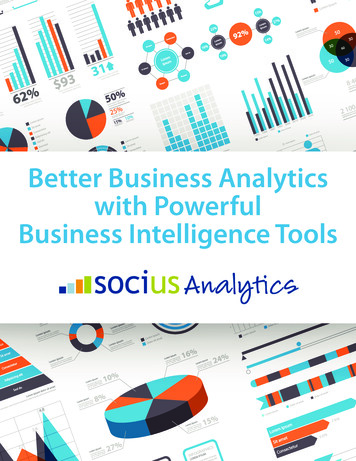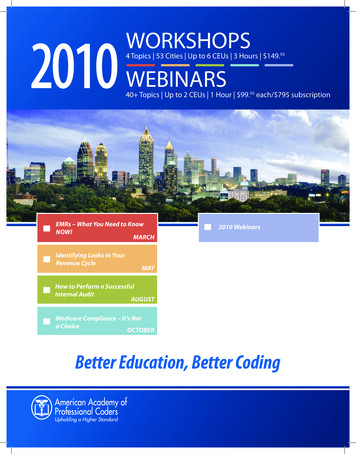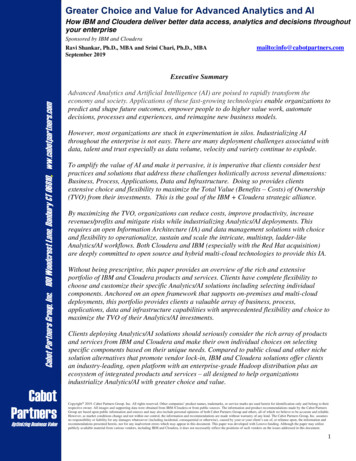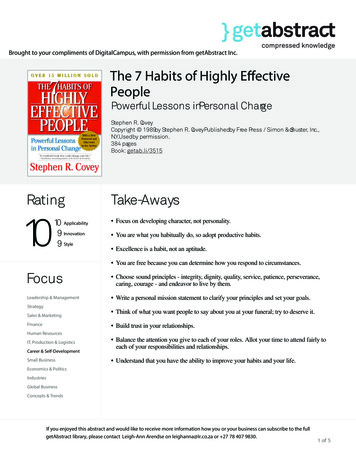
Transcription
Better Business Analyticswith PowerfulBusiness Intelligence Tools
Business Intelligence DefinedThere are many interpretations of what BI (Business Intelligence) really is and the benefits that it can deliverfor a business. It can be described several ways, but here are a few our favorite definitions:“The process for exploring and analyzing structured, domain-specific information to discern businesstrends or patterns thereby deriving insights and drawing conclusions.”– Howard Dresner, The Gartner Group.“Quality information in well-designed data stores, couples with business-friendly software tools thatprovide knowledge workers timely access, effective analysis and intuitive presentation of the rightinformation, enabling them to take the right actions or make the right decisions.”– Larry English, The Beye Network.Why BI?With BI you are able to create an organization that is constantly adapting and that embraces the changingmarket place to stay one step ahead of the competition. BI is not centered on data warehouses, but insteadfocuses on creating a learning organization, constantly aware of what your business has done in the pastand using that information to plan for the future.In this guide, you will learn: Challenges that your business may be facing that could signal your need for BIThe value of BI for the various areas of your businessBI tools that are available to youBest practices to implement BI solutionsConsiderations for BI projects800.589.6614 www.socius1.com info@socius1.com
Challenges Faced by Organizations Without BIIn order to gain the full benefits of what BI has to offer your business, it is important to understand whatsome of the major hurtles for adoption are and design a plan to overcome these problems.1. Performance management only occurs once a month or once a year – When you are only managingyour performance efforts once a month to once a year, you are not giving yourself the right amount of timeneeded to notice issues, correct problems, and make the important changes necessary to implement newideas and corrections. Make time to evaluate performance on a more regular basis. BI tools allow you to dothis easily and with the right data you need to make good decisions.2. Multiple sources or queries of data – Whenyou have salespeople reporting in a differentstructure, from different sources than CFOsand other members of your organization, thetruth tends to be twisted, and this leads toinefficient, poor decisions being made. Be sureeveryone is on the same page when it comesto reporting so you never have more than oneversion of the truth.3. Manual assembly of information - Whenyou have employees who need to manuallyassemble information and reports, you introduce the risk to the data integrity. There is nobusiness logic to protect data from mistakes.Protect your data and don’t allow for the possibility of data integrity issues.4. No view of the performance of key business strategies - Consider the example of playing in a soccergame; you always have the score in front of you so you can constantly see and review your performanceand adjust your game plan accordingly. You can work head to head against the score. If you don’t havethe score, or in our case key business strategies and performance, then you have no way to plan your nextmoves according to your progress.800.589.6614 www.socius1.com info@socius1.com
Challenges Faced by Organizations Without BI (cont.)5. Reliance on IT to develop custom reports – Stop relying on IT staff to develop your reports for you. Thistakes time out of your schedule and the IT personnel. This causes data reports to not always be the mostup-to-date. You are less reactive. With self-serve BI, you can create your own custom reports with up-to-theminute information so you are always prepared. Never again will you be slow to identify underperformingareas of the business.6. Always looking in the rear view mirror – Itis important to make the switch from focusingon “what already happened” to “what do wethink is going to happen.” This can be challenging without the proper information toguide you. BI empowers you to feel confidentand be successful with this shift in thinking.7. “Spreadmarts” – Spreadmarts, or spreadsheet marts, occur when all of your businessprocesses are recorded and reported in multiple spreadsheets. These are cumbersome andextremely difficult to manage and understand.Keep your business process information inone location that is accessible by all and easyto manage.8. Too much energy spent on compiling instead of analyzing data – With the BI tools available to youtoday, your time can be spent much more efficiently. You can stop spending the larger portion of your timegathering and interpreting data, and instead be spending that time analyzing the data to implement newstrategies and ideas.9. Difficult to provide information in the way people best consume data – The mobile world is taking over.If you and your team does not have the ability to access information on the go and on whatever device isavailable, then you are going to fall behind.800.589.6614 www.socius1.com info@socius1.com
The Value of BI Across Your BusinessBreak down the walls between the front and back offices. Your remote sales team, customer service, andmarketing teams need access to the same CRM or ERP data that your accounting and finance teams in theback office has. BI tools give you the ability to break down the barriers within your office so all users havethe same access and can easily make decisions based on important information. Many organizations todaywaste most of their time dealing with lack of access to this data and spend valuable time tracking it down.The Business Value of BI With the proper business intelligence tools available, you canachieve improved employee and management communication. Thishelps to create just one single version of the truth. Data collection processes are improved to help make for cleaner andmore trusted data. Your employees have quicker access to information. They can be assured that they are getting the most up-to-date information becausedata is being updated on a weekly rather than a monthly or yearlybasis. BI creates a safer environment for you to create “what-if” scenariosand learn from them to make better, data supported decisions.The IT Value of BI There is a greater reduction in report requests. Because of the selfservice BI model, data is available 24/7 to your organization. There is a lower administrative cost for BI infrastructure. There arereduced repositories for all business information and cloud serviceoptions. Have more time for valuable IT resources like next generation IT projects. Because daily administrativetasks are lowered, your team can spend their time more efficiently. IT should be your first partner and one of your biggest allies in working with BI whether is it with a specific project, data warehousing, or just overall management of the system.800.589.6614 www.socius1.com info@socius1.com
The Value of BI Across Your BusinessThree Distinct Audiences for BIPersonal BI: AnalysisMany times these people want to spend their time in Excel. Thesemembers want to be able to look at their data in a trustedenvironment so they can work with the data to forecast the future.Team BI: AccountabilityThese teams work with monthly or weekly financial updates that arestructured but available on a wide scale for people to make timelybusiness decisions.Corporate BI: MonitoringCorporate goals are set and put out for the whole company to seeand it is updated on a daily basis.800.589.6614 www.socius1.com info@socius1.com
Business Intelligence ToolsSimple Pivot Chart using Excel – These are easy to access, easy to pulland to use. You can slice and dice data, use what if tools, and drive intomany different data elements.Excel Chart – These are good to use when looking at things like support volume or revenue trends. Excel does a good job of pulling yourdata wherever it may be.Power BI: Power View – This is a suite of solutions available with Office365 that runs out of the cloud. Power view is a graphical view that isavailable that is easy to use and the visual dashboard makes it easy tospot daily trends. Because it can be created by the end user, IT doesnot need to be involved in the process.Power BI: Power Map – This solution consists of compiling information like number of sales, customers, orstore locations in a geospatial map in one city or across the world.Power BI: Power Q&A – This solution provides data visually and gives you the ability to type in questions.This eliminates the need for queries or changing pivot tables. You have the ability to save your findings andshare your questions so others can add to or adjust the question to meet their own specific needs.Strategy Map: Visio – This strategy map solution allows you to click and drill down on larger pieces ofinformation so you can get more details. If you see an area where sales are going down, you can click onthat spot to drill-down and get a better look into the why behind those numbers.Decomposition Tree – This solution is available through SharePointEnterprise. A decomposition tree expands prices and products for eacharea of your business. A benefit with this solution is that you can visuallysee specifically where each piece of data is coming from.Reporting and Planning – Reporting and planning solutions are available for corporate performance management and as a forecasting solution. You are able to look at data in different time periods, from differentbusiness entities, in the form of other currency, and others.800.589.6614 www.socius1.com info@socius1.com
Business Intelligence Tools (cont.)Budget/Actual Forecasting – This solution givesyou the budgeted and actual forecasts in a grid viewrather than a graphical view. This makes it easierto view based on customers, locations, products, orother financial metrics.Reporting Via SharePoint – Because these reports arepublished on SharePoint, they are available across thecompany. But they can remain locked down so usersare able to view and drill-down to see valuable information without altering data.Monitoring – You are able to monitor key performance indicators (KPIs) to measure performance at alllevels of your organization. The real-time dashboardssend you alerts to help you spot trends, catch problems early on, and spot opportunities.Multi-Panel Dashboard – This solution allows you to interact with PivotTables, add filters, and sort datawithin a browser. You can create rich dashboards within SharePoint with the many new programmabilitycapabilities.Operational Dashboard – These dashboard solutions are good to use ifyour business has very specific requirements and business needs. Eventhough it does take more time to develop, this solution gives you themost flexibility for your unique business needs.Personal/Team/Company Dashboard – This is information that canbe viewed by the entire company, or just your team. You can see timeworked, paid time off, top projects, featured projects, and other aspects ofyour work as it stands today or over a historical period of time.800.589.6614 www.socius1.com info@socius1.com
Best Practices for BI ImplementationIt is critical to keep in mind that no matter how great an idea is, the success of that idea all depends on thepull through throughout the organization, especially within upper management, or else it is bound to fail.Here are some best practices to be sure to incorporate within your BI implementation plan. Clearly define objectives and goals – It is recommended that you choose to spend much of your focuson the big three to five to really push across the organization. That way you get the main points acrossand don’t need to worry that your employees will forget or misinterpret your company goals. Gain organizational buy-in – The importance of acceptance from upper management and organizational leaders cannot be stressed enough. If your plan is not embraced by everyone within your company,then it is never going to accomplish all of your goals. Inventory your various information sources and tools – As you are doing so, ask yourself some important questions: What databases and data sources contain information? How is reporting done today?How can we deliver needed, important information? Understand and prioritize current user needs– What information isneeded? What users needthat information? At whatfrequency is it needed?And what is it needed for? Understand user needsthat are not met – Whoseneeds are not being met?How can we work to meetthose needs in the mostefficient way?800.589.6614 www.socius1.com info@socius1.com
Tips for Successful BI Projects As you are considering a BI project for your organization, you should eliminate unnecessary databases. Work with your vendors to find the most cost efficient solution for your business, as licensing costs canget high. Always try before you buy; utilize proof of concepts to make sure that you are picking the right choice foryour organization. Build a roadmap by working with your IT department to find out what type of products and solutionsyou need to make sure that you are not overlapping where you don’t need to. “See” your data rather than just viewing it in rows and columns. Ask what data you want to be able to seeon your dashboards so you can have the right data at the right time. And finally, as stated before, evangelize and make sure that senior people are supporting the solution forfull adoption throughout the whole organization.Get StartedContact Socius today to get started building the best BI solution for your business:800.589.6614 www.socius1.com info@socius1.comAbout SociusBacked by 30 years of award-winning experience,Socius serves clients throughout the country from itsheadquarters in Columbus, Ohio and our 25 additionallocations. Socius combines Innovative Technology,Experience, Expertise and Partnerships to uniquelyprovide clients with insight, productivity, and collaboration across their entire business so that people becometheir most powerful asset.sociusThe Power of Partnership
800.589.6614 www.socius1.com info@socius1.com The Value of BI Across Your Business Break down the walls between the front and back offices. Your remote sales team, customer service, and marketing teams need access to the same CRM or ERP data that











